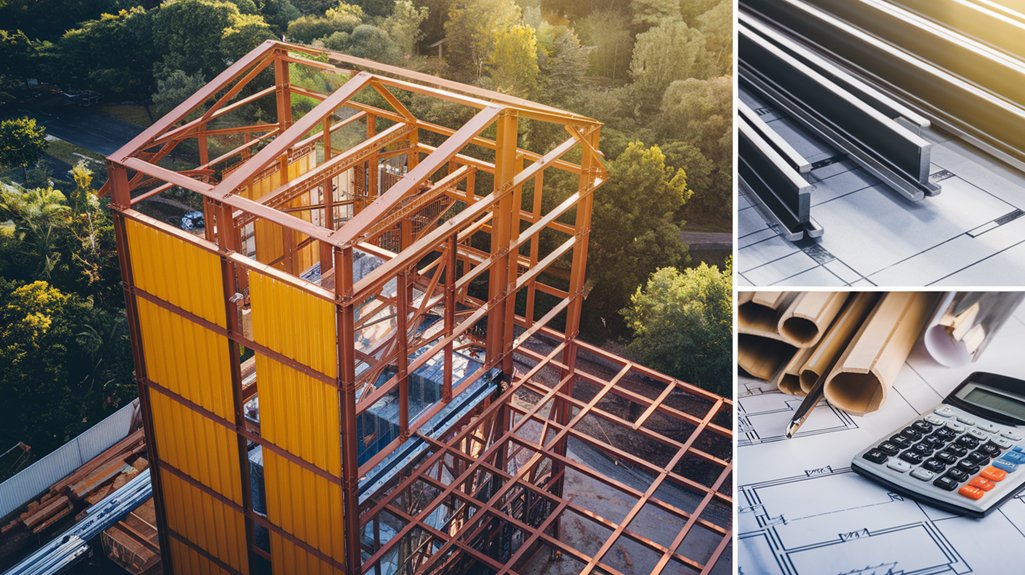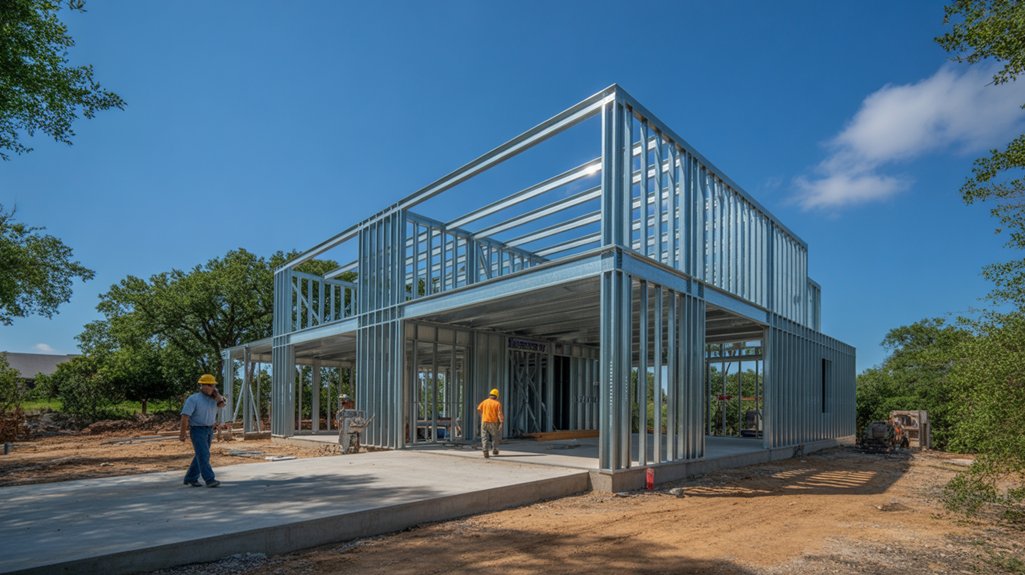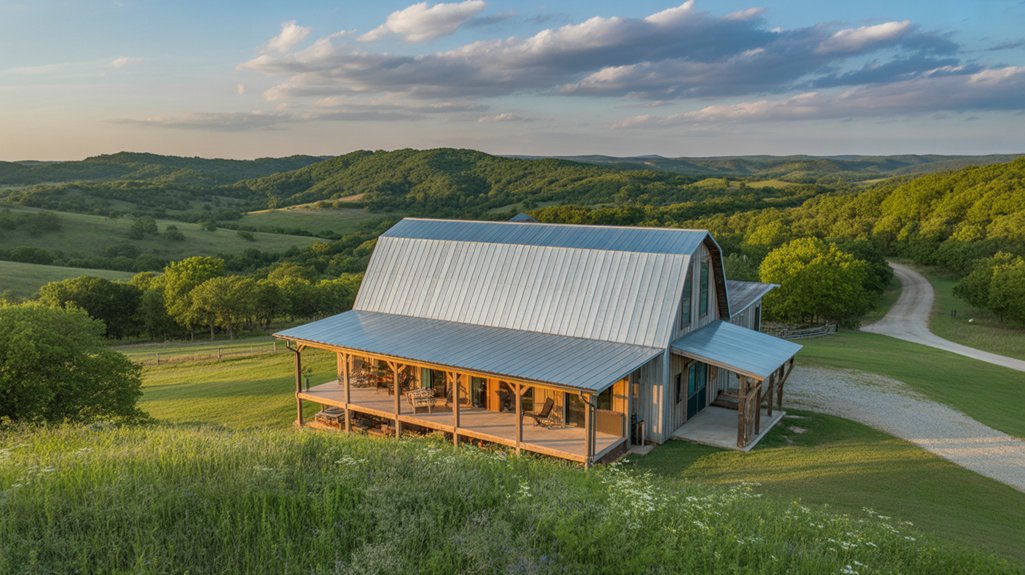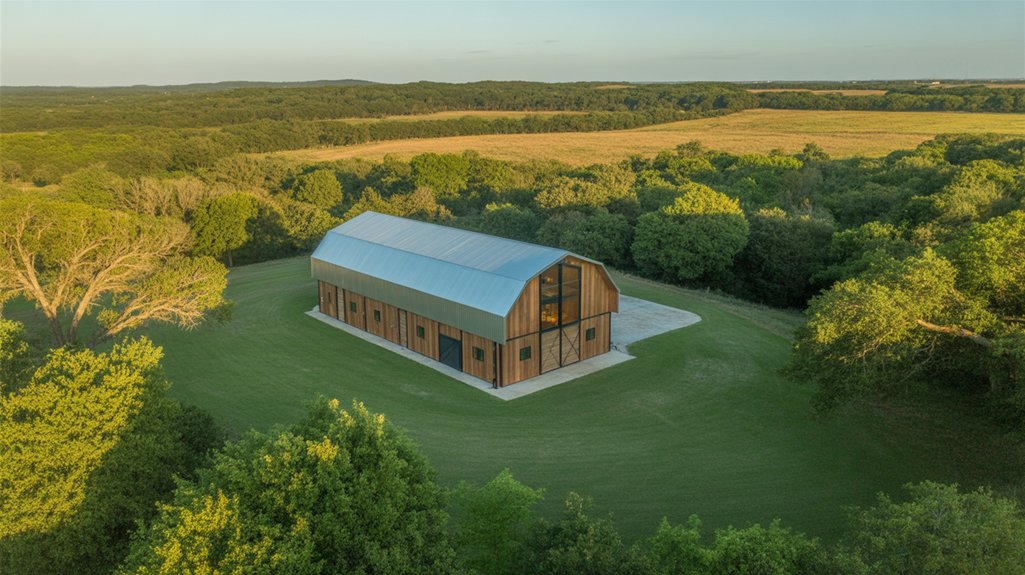Skip to contentSteel vs. Wood: Choosing the Right Material for Your Building
When planning a construction project, the decision of steel vs wood in construction can significantly influence your results. Steel offers modern durability, while wood provides natural beauty. This article explores key differences—from cost and sustainability to installation and aesthetics—to help you make an informed decision.
Key Takeaways
- Steel lasts over 50 years; wood averages around 30 with upkeep
- Steel is low maintenance; wood needs regular treatment
- Wood is cost-effective initially but may incur higher long-term costs
- Steel suits commercial builds; wood is ideal for warm residential spaces
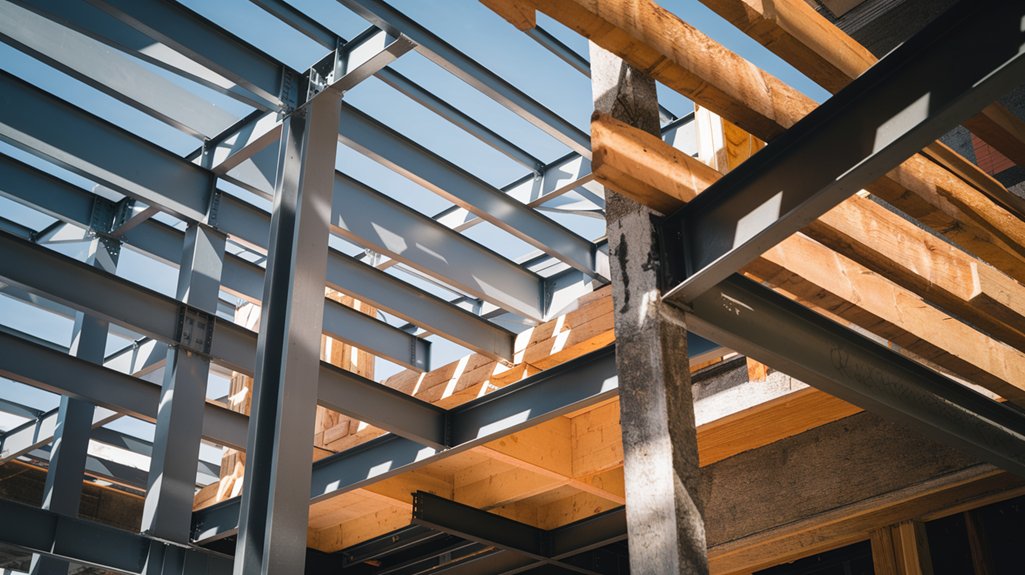
Overview of Steel and Wood in Construction
Steel is favored for its strength-to-weight ratio and consistency, making it ideal for commercial or tall structures. Wood, meanwhile, excels in insulation and flexibility—great for residential homes. Explore how steel evolved into a modern building material.
Durability and Lifespan
- Steel: Moisture/pest resistant, minimal maintenance, 50+ year lifespan
- Wood: Natural material, susceptible to pests and rot, requires upkeep
Aesthetic Appeal
Steel offers sleek, industrial designs perfect for urban and commercial builds. Wood provides visual warmth and a traditional look, often chosen for residential projects. Your choice should match your functional and emotional goals for the space.
Cost Comparison
| Factor | Steel | Wood |
|---|
| Upfront Cost | Higher | Lower |
| Labor Cost | Moderate-High | Low |
| Maintenance | Minimal | Ongoing |
| Long-Term Value | High | Moderate |
Sustainability and Environmental Impact
Wood is renewable and biodegradable. Steel is recyclable and long-lasting. Both have eco-benefits depending on sourcing and usage. Learn more from the American Wood Council.
Maintenance Requirements
- Steel: Occasional rust inspection, basic cleaning
- Wood: Regular treatments for moisture and pests
Strength and Load Capacity
Steel has superior tensile and compressive strength. It’s often used in earthquake-prone or industrial settings. Wood performs well under moderate loads but is more vulnerable to shifting environmental conditions.
Fire Resistance and Safety
Steel is non-combustible and often lowers insurance premiums. Wood is flammable but can be treated for improved resistance. Always check local fire codes when selecting materials.
Installation Process and Timeline
Steel is often prefabricated, leading to faster assembly and reduced labor time. Wood requires custom cutting and is more affected by weather, potentially slowing down the process.
Regulatory Considerations
- Always verify zoning and material codes with your local authority
- Ensure fire and seismic compliance for your chosen material
- Permits and inspections will vary based on location
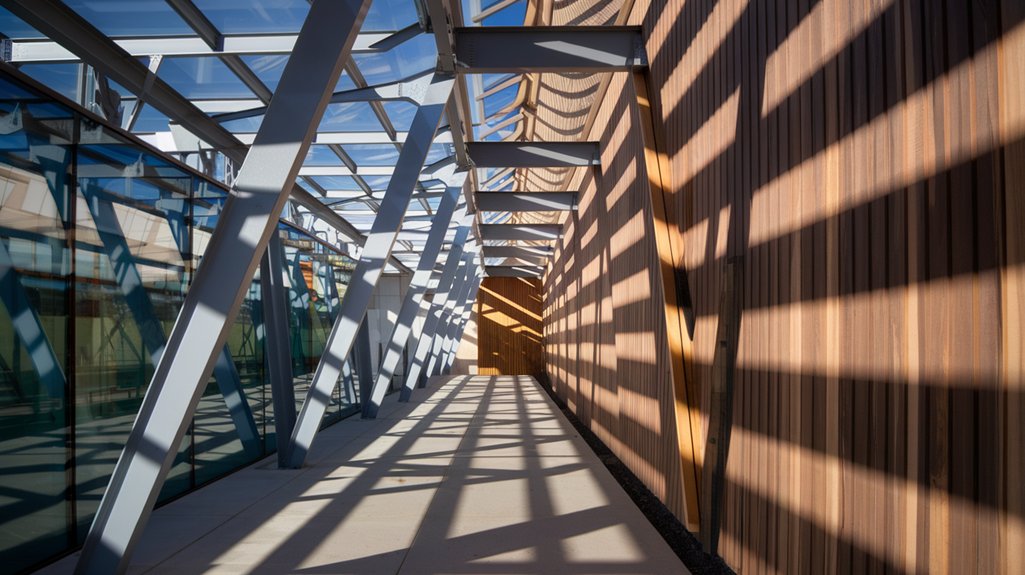
Frequently Asked Questions
What’s better for homes—steel or wood?
Wood suits cozy aesthetics and insulation; steel offers longevity and low maintenance.
Can I use both in one building?
Yes—hybrid structures are becoming popular, combining the warmth of wood with the strength of steel.
Does insurance differ between materials?
Yes. Steel may yield lower premiums due to fire/pest resistance.
How does climate affect my material choice?
Steel suits all climates; wood may require additional protection in humid or termite-prone areas.
Choosing between steel vs wood in construction depends on budget, durability, and design preferences. Steel provides long-lasting strength and minimal upkeep, while wood offers warmth and traditional beauty. Weigh your project’s needs, aesthetic goals, and maintenance capabilities to select the best material.
At Suburban Buildings, we help you select the right structure for your vision—whether you choose modern steel or classic wood aesthetics. Get in touch today to start planning your build.
wood vs steel, wood steel, steel wood, is wood stronger than metal, wood vs steel strength, wool steel, structural comparison between wood and steel, steel vs wood buildings, is steel stronger than wood, will wood age
steel building, barn, metal, manufacturing, steel, carport, garage, roof, construction, shed, warehouse, price, budget, design, barndominium, recreational vehicle, building material, farm, wood, missouri, warranty, north carolina, pest, hangar, agriculture, west virginia, illinois, financing options, hidden, indiana, new mexico, sms, new jersey, zip code, ohio, credit score, kentucky, iowa, extreme weather, tennessee, snow, virginia, kansas, customer service, mississippi, vehicle, south carolina, georgia, wisconsin, pennsylvania, contract, colorado, arkansas, minnesota, dream, garage door, payment, alabama, asset, tool, space, michigan, arizona, heat, self storage, new hampshire, aircraft, factory, workshop, paint, arena, maintenance, horse, utah, mexico, jersey, framing, maryland, lumber, metal roof, livestock, oklahoma, concrete, credit, louisiana, vermont, nevada, corrosion, frequency, truss, connecticut, cost, delaware, ship, lead, rain, boat, pride, information, engineer, stucco, massachusetts, customer satisfaction, custom metal buildings, info, steel building industry, products design, commercial metal building, custom metal, contractor, north, custom metal building, free delivery, owner, building, steel building financing, delivery and installation, garage doors, buildings, custom steel building, contact, commercial steel building, delivery, components, website, installation, steel buildings texas, dallas, building insulation, prefabricated building, tornado, building code, termite, houston, structural steel, wind, energy, plant, san antonio, investment, aviation, steel frame, captcha, purlin, rust, girt, structure, metal building kits texas, 40x60 metal building texas, metal barns texas, metal building manufacturers in texas, metal homes texas, houston metal supply, steel buildings san antonio, steel building supply center tx, steel buildings lubbock, texas metal builders, texas choice steel buildings, steel buildings for sale in texas, dallas steel buildings, metal buildings san antonio, general contractor, window, request price, free estimate, south texas, text messaging, better business bureau, village, lighting, innovation, severe weather, distribution center, environmentally friendly, ventilation
Frequently Asked Questions
Can I get metal building permits in San Antonio easily?
Getting metal building permits in San Antonio can be easy if you follow the local guidelines and requirements. Working with a knowledgeable construction service can streamline the process and ensure compliance with regulations.
How long do steel buildings last in Texas?
Steel buildings in Texas are renowned for their durability, typically lasting 40 years or more with proper maintenance, thanks to their resistance to harsh weather conditions and pests.
Are metal buildings energy efficient?
Metal buildings are energy efficient due to their reflective surfaces and insulation options, which help reduce heating and cooling costs. This makes them a sustainable choice for both residential and commercial purposes.
How are metal buildings more durable than traditional buildings?
Metal buildings are more durable than traditional buildings due to their resistance to weather, pests, and corrosion. They are engineered to withstand extreme conditions, providing greater longevity and reduced maintenance needs compared to conventional construction materials.
What is the cost of building a metal structure?
The cost of building a metal structure varies based on factors like size, design, and materials used. Generally, prices can range from $10 to $30 per square foot, but a detailed quote will provide the most accurate estimate tailored to your project.
How much do steel buildings cost in Texas?
The cost of steel buildings in Texas varies based on size, design, and customization options. Typically, prices range from $10 to $20 per square foot, depending on these factors, so consulting with a contractor for a detailed quote is recommended.
What are the benefits of metal buildings in San Antonio?
The benefits of metal buildings in San Antonio include durability, low maintenance, cost-effectiveness, and quick construction. They provide versatile spaces suitable for both residential and commercial needs, making them an excellent choice for various projects.
Can metal buildings be customized to fit specific needs?
Metal buildings can indeed be customized to fit specific needs. At Suburban Buildings, we offer tailored designs that cater to both residential and commercial projects, allowing you to specify dimensions, layouts, and features according to your requirements.
What are popular steel building uses in Texas?
Popular steel building uses in Texas include agricultural structures like barns, residential barndominiums, commercial warehouses, retail spaces, and workshops. Their durability and versatility make them ideal for various projects across the state.
Are metal buildings resistant to natural disasters in San Antonio?
Metal buildings are highly resistant to natural disasters in San Antonio. Their steel construction offers superior durability against high winds, heavy rain, and other extreme weather conditions, making them a reliable choice for safety and longevity.
What are the benefits of using metal buildings for construction?
The benefits of using metal buildings for construction include durability, low maintenance, energy efficiency, and customization options. These structures are designed to withstand harsh weather conditions and can be tailored to meet specific residential or commercial needs.
What is the average lifespan of a metal building?
The average lifespan of a metal building is typically between 40 to 60 years, depending on factors such as construction quality, maintenance, and environmental conditions. Proper care can extend this lifespan even further.
What types of metal buildings are available?
The types of metal buildings available include barndominiums, post-frame structures, and custom metal buildings designed for both residential and commercial use, ensuring durability and versatility to meet various client needs.
How are steel buildings tested for durability?
Steel buildings are tested for durability through rigorous inspections, including load tests, corrosion assessments, and structural integrity evaluations, ensuring they meet safety standards and withstand environmental factors.
What climate factors affect metal buildings?
Climate factors that affect metal buildings include temperature fluctuations, humidity levels, and precipitation. These elements influence structural integrity, insulation efficiency, and potential for rust, requiring careful design and material selection to ensure durability.
Can I obtain financing for metal buildings?
Financing options for metal buildings are available. Many lenders and financial institutions offer loan programs specifically for construction projects, including barndominiums and metal structures. It’s advisable to explore local financing options and consult with your lender for specific terms.
What is the average time to construct a steel building?
The average time to construct a steel building typically ranges from a few weeks to several months, depending on the complexity of the design and project specifications. Factors such as site preparation and weather can also influence the timeline.
Are customized metal buildings more expensive?
Customized metal buildings generally come at a higher cost due to their tailored design and unique specifications. However, this investment often yields greater long-term value through enhanced durability and better functionality.
How do metal buildings compare to wood structures?
Metal buildings offer superior durability, lower maintenance costs, and resistance to pests compared to wood structures. While wood may provide aesthetic warmth, metal is typically more cost-effective and long-lasting, making it a practical choice for various construction needs.
What types of insulation are best for metal buildings?
The best types of insulation for metal buildings include spray foam, fiberglass batts, and rigid foam board. These options effectively minimize thermal transfer, reduce condensation, and enhance energy efficiency within the structure.
Do metal buildings have warranty options?
Metal buildings do have warranty options available. Many manufacturers and contractors, including Suburban Buildings, offer warranties that cover structural integrity and material defects, ensuring peace of mind and long-lasting quality for your investment.
Can metal buildings be relocated?
Metal buildings can be relocated. With proper planning and the right equipment, these durable structures can be dismantled and moved to a new site, allowing flexibility for your residential or commercial needs.
What zoning laws affect metal building construction?
Zoning laws that affect metal building construction include regulations on land use, building height, setbacks, and architectural design. These laws vary by location, so it's essential to consult local authorities to ensure compliance.
How do I maintain a steel building?
Maintaining a steel building involves regular inspections for rust, cleaning surfaces to remove dirt and debris, ensuring proper drainage, and checking structural integrity. Additionally, applying protective coatings can enhance durability and prolong the lifespan of the building.
Are there eco-friendly options for metal buildings?
Eco-friendly options for metal buildings do exist. Many manufacturers now offer recycled steel and sustainable construction practices, reducing environmental impact while providing durable and energy-efficient structures.
What finishes are available for metal buildings?
The finishes available for metal buildings include options such as painted, galvanized, and powder-coated surfaces. These finishes not only enhance aesthetics but also provide added protection against weather and corrosion, ensuring durability and longevity.
Can I use metal buildings for commercial purposes?
Metal buildings are suitable for commercial purposes, offering durability and versatility. They can be customized for various business needs, making them an excellent choice for warehouses, retail spaces, and offices.
Are there fire safety concerns with metal buildings?
Fire safety concerns with metal buildings are minimal, as steel is non-combustible and can withstand high temperatures. However, proper insulation and fire-resistant materials should be used to enhance safety and meet local regulations.
What are the most common metal building sizes?
The most common metal building sizes typically range from 20x30 feet to 60x100 feet. These dimensions are popular for various applications, including garages, workshops, and barndominiums, catering to both residential and commercial needs.
How do I choose a metal building contractor?
Choosing a metal building contractor involves evaluating their experience, reputation, and portfolio. Look for licensed professionals who prioritize quality workmanship and customer satisfaction, and don’t hesitate to ask for references or past project examples to ensure you make an informed decision.
metal buildings san antonio, steel buildings texas, home builders in boerne tx, carports boerne tx, suburban buildings, metal carports boerne texas, boerne texas carports, metal carports boerne tx, metal buildings of texas, metal building homes texas, pole barn builders in texas, metal building contractor near me, pole barns in texas, texas metal buildings, metal buildings texas, metal building construction texas



